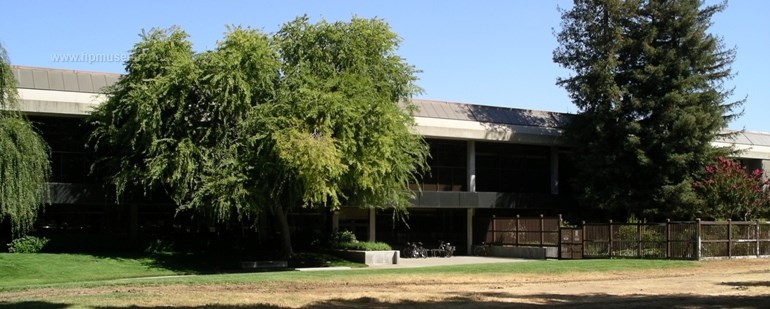Data Systems
 | |
| Founded: 1972 | |
| Address: 11000 Wolfe Road, Cupertino California. | |
| Data Systems Division Building 42 in Cupertino | |
Description:
The Data Systems Division was formed in March of 1972 with the merger of the Mountain View and Cupertino Divisions. The division began its life in considerable difficulty. The 21XX series of computers was performing strongly, but the new HP3000 project (the company’s most expensive R&D project to date) was well off the rails.
In February of 1973, David Packard asked Paul Ely to move from his position as GM of the Microwave Division to Cupertino to run DSD and fix the problems with the 3000. Ely replaced George Newman who had been in his role less than a year. Ely reorganized DSD to fix the 3000 project and spent the next dozen years becoming the most influential figure in the first two decades of HP computing.
In 1972, DSD shipped HP's 4,500th minicomputer.
In August of 1973, HP shipped its 6000th minicomputer (a 2100 to Allen-Bradley Company); in February of 1974, HP shipped its 8000th minicomputer. In February of 1975, HP shipped its 10,000th minicomputer. In March of 1974, DSD introduced the new 21MX computers, the first in the industry to use semiconductor memory. The 21MX computers maintained software and interface compatibility with the previous generation 21XX computers. In 1977, this range of computers was renamed HP-1000. By 1978, the HP-1000 range included the M-Series (original 21MX), E-Series and F-Series. The last of these computers was not obsoleted until 1989, meaning HP offered full compatibility with its first ever computer for 23 years.
Other DSD shipping milestones in 1974 included the 3000th 7900 disc drive in August and the 4000th magnetic tape drive (primarily 7970) in July.
In October of 1974, HP formed the Computer Systems group which included DSD, the Boise Division and the Advanced Measurement Division. Paul Ely was appointed head of the new group. At the time, the Computer Systems Group had annual revenues of $170M and employed 4,500 (of HP's 29,000) staff. Dick Anderson replaced Ely as the general manager of DSD.
In May of 1975, DSD received its largest ever single order to date (nearly $3M). The order was developed by Colin Howard of Australia. The customer was the New Zealand State Services Commission.
In August of 1975, DSD spawned two new divisions. The General Systems Division was responsible for the HP 3000 line (as well as 2000 timeshare systems) and the Terminal Products Division was responsible for the recently-developed 2640 terminals. DSD retained responsibility for the HP 1000 computer line.
In January of 1978, DSD absorbed the Advanced Measurement Division with Dick Anderson in charge of the combined entity. In May of 1978, HP established a dedicated large scale integrated-circuit operation within DSD. The Cupertino LSI Operation was managed by Paul Greene. In August of 1980, responsibility for all DSD measurement and control products (eg 2240A) was transferred from Cupertino to Roseville.
Sales of HP 1000 computer systems grew by 67 percent between 1977 and 1979 (to $144 million per year).
In early 1980, DSD introduced the new format HP 1000 systems, the L-Series. The L-Series computers were based on HP's proprietary, and soon to be ill-fated, silicon-on-saphire (SOS) technology.
In September of 1980, Gaylan Larson was named general manager of DSD. In February of 1982, DSD introduced the HP1000 A600 and A700 computers capable of handling a million instructions per second. These new A-Series computers replaced the L-Series computers. The A-Series computers were to be the final platform of the HP 1000 range. The A900 followed later that year. The 1000/A900 computers were so fast, they were bound by special US government export restrictions. Automatic export approval was given for only 16 countries. Export to any other country required an individual license.
In January of 1983, Franz Nawratil became the general manager of DSD. In July of 1984, Jim Burns became the new general manager of Data Systems Division. Sales of HP 1000 computer systems peaked in 1984 at just over $200 million (not including peripherals). The business declined quickly thereafter to be less than $50 million by 1990.
In June of 1986, HP’s first PA-RISC computer (9000 model 840) was jointly released by the Fort Collins System Division and the Data Systems Division. The new technology was designed to merge the two divisions’ product lines and strategies over time. However, the new RISC Unix machines were never really able to fully replace the HP 1000 RTE computers.
In November of 1986, DSD introduced the HP1000 A400 at the Autofact show.
In February of 1988, two new divisions replaced the Data Systems Division, Technical Computer Operations, Fort Collins Systems Division and Technical Workstation Operation. Jim McCabe became the GM of the new Technical Systems Division (in Sunnyvale) and Chris Christopher became the GM of the new Graphics Technology Division in Fort Collins.
HP sold the Cupertino campus to Apple and vacated the site at the end of 2012.
| Back | Division Documentation |
^ TOP©2004 - 2024 BGImages Australia - All Rights Reserved.
The HP Computer Museum and BGImages Australia are not affiliated with HP Inc. or with Hewlett Packard Enterprise. Hewlett Packard and the HP logo are trademarks of HP Inc and Hewlett Packard Enterprise. This website is intended solely for research and education purposes.
